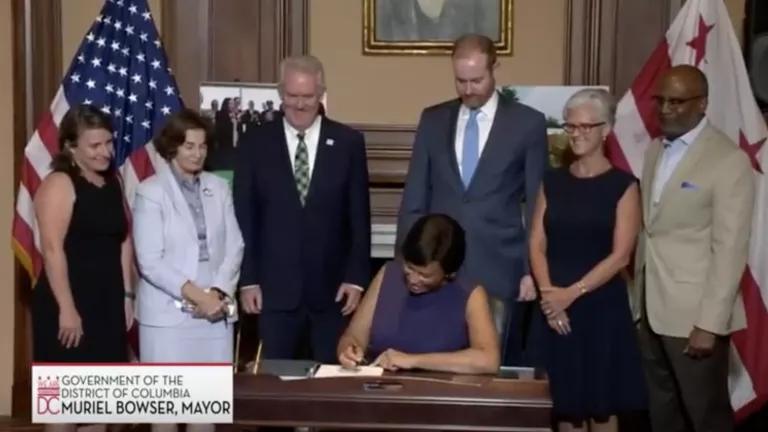Hot in DC: Green Bank Edition

It was sultry here in DC yesterday, but that was not the hottest news in my opinion. Mayor Muriel Bowser signed legislation to create a Green Bank here in Washington, D.C., following City Council passing the bill unanimously. Green banks use public capital to reduce risk and crowd in more private investment in clean energy and other infrastructure. The first in the world was in the United Kingdom and the first in the U.S. was in Connecticut. And, now, this will be the very first city full green bank in the country. That is big news for DC—especially for someone like me that lives in the District and works on green bank issues every day at NRDC. DC is pioneering using these tools at the city level to take limited public funds to dramatically increase clean technology deployment. Cities around the country can look to DC’s leadership for how to lead into the clean future.
Officially named the Green Finance Authority, but generally called the DC Green Bank, it will help increase private investment by reducing risk, creating markets and educating stakeholders, all to help the District meet its very strong climate goals and targets, including the Mayor’s December announcement to make even more aggressive targets for the District to be carbon-neutral and climate resilient by 2050, up from an earlier DC commitment to reduce greenhouse gas emissions by 80% by 2050.
It can be “easy to make these proclamations,” Tommy Wells, Director of the Department of Energy and Environment said, “then, we have to figure out how to do it.” The Green Bank is one of the tools to help cost-effectively meet environmental goals. Meeting the goals will require significant investment in renewables, energy efficiency and resiliency—far more money than the District government can provide alone. The District already has several programs in place to help specific segments of the market, like C-PACE for energy efficiency and clean energy in commercial properties, building codes for new buildings to increase energy efficiency and stromwater runoff, Solar for All for low-income households, but the shift will require even more investment, including much more from private investors. And, it needs to happen very quickly in district buildings, renewables and other infrastructure.
At the signing ceremony yesterday I had the honor of joining, the Mayor said, “we cannot wait another day.” Green banks can help speed up the transition pulling in the best of the private sector, with a little nudge from the public sector. Specifically, green banks focus on the projects are very close to financeable, aka able to get a loan or other financing, but just are not happening on their own. Green banks can step in to fill a gap or take on some of the risk for being an early mover, like lack of a repayment history for new types of energy efficiency loans. Green banks can also help educate consumers and investors on the economic benefits of energy efficiency and solar, using experienced, specially trained staff to provide high quality information to DC residents. The goal is to fill those gaps in the short-term, so that private investors learn that the projects are profitable and eventually do not need green bank support to find private investment.
Mayor Bowser also highlighted the Green Bank’s role in creating well-paying, clean energy jobs for residents across the District, including in less affluent areas. The DC Green Bank is putting equity and helping low-income DC residents at its core, with two of the 7 voting board members required to have affordable housing or community development experience. The green banks are intended to focus on where there are gaps—and affordable housing is certainly a DC gap.
The new Green Bank will be initially capitalized with $7 million from the Renewable Energy Development Fund with reoccurring infusions each year for 5 years. City Councilmember Mary Cheh introduced legislation to add another $70 million to the DC Green Bank, which would bring total capitalization to $105 million.
NRDC has been a proud supporter of the DC Green Bank and green banks around the world, including through the Green Bank Network. Stay tuned here and on greenbanknetwork.org for updates on initial investments by the DC Green Bank and work around the world to use the tools of green banks to increase investment in clean energy and resilient infrastructure.




